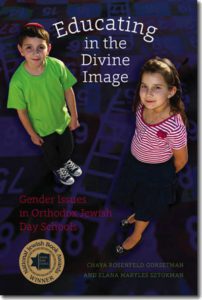
[Adapted from the new book, Educating in the Divine Image: Gender Issues in Orthodox Jewish Day Schools, by Chaya Rosenfeld Gorsetman and Elana Maryles Sztokman]
Part 2, continued from last week:
Connections between a woman’s dress and her perceived sexuality are commonplace in many Jewish schools. Avital Chizhik, writing in Tablet about her experiences in modern Orthodox institutions trying to balance “Torah U’Madda” – Jewish tradition and a life of modernity – touches on the connection between modesty and sex education:
“My younger sisters, who still attend that all-girls high school, have been alluding to problems with particular teachers…One sister began to cry as told me how her rabbi had told the class that one who transgresses the boundaries of forbidden physical contact, even in the most casual and unaffectionate of manners, a mere handshake, is considered adulterous and thus is deserving of death, according to biblical law. “That just makes me want to go to the Gap and buy a pair of skinny jeans,” she told me, pulling her denim skirt to cover her knees as she sat down.
“Another teacher announced proudly that the walls of her house have never seen her hair, just like the righteous mothers of the Talmud. “I sleep with my head covered, girls. Always.” Her stories reminded me of my own teachers, including one who had quoted the Talmud on bestiality and then added in half-jest, “Now, you may say that bestiality is irrelevant today, but I’m not sure, looking at the way Western society is today … it might just be the next big thing.”[2]
A teacher’s allusion to punishment of death for casual touching leads the student to thoughts of rebellion that find expression in wearing jeans. A teacher’s story about fanatic practices of hair-cover becomes a reverent commentary on the intimate life of a Jewish woman. In Jewish schools, women’s and girls’ clothing is regularly interchanged with commentary about sexual behavior. “So much, it seemed, depended on covering ourselves,” Chizhik concluded, “and in some circles, it still does”.
Language of “modesty” becomes the central tool for transmitting messages about sexuality and relationships in many day schools. The hidden curriculum about sexuality and intimate relationships is transmitted in the same ubiquitous way that messages of “modesty” are. After all, the entire premise of “tzniut” is that the female body is an object of male desire and need to be covered. Whether this discussion takes place as early as the first grade before children understand what sex is, whether the lesson is transmitted among LGBT students, whether the conversation is in science class, halakha class, or gym, the introduction of norms of modesty necessarily entails a socialization into perceived heterosexual normative behaviors. And in many Jewish schools, this remains the dominant mode of sex education throughout a child’s education. [3] One educator admitted that he believed in discussing sexual activity (or rather the need for abstinence) even from fourth grade: “ I think that it is self evident that one should teach our students about all halachot that we expect them to observe. As the laws often called “negiah,” as well as laws forbidding (among other things) pre-martial sexual relations, are certainly laws we want them to observe, we need to teach them (I bring up the subject of “negiah” in 4th-5th grade, within the context of our Mishna study. I feel it’s important that they’ve heard of this prior to their developing “interest” in the opposite sex.)”, he wrote. “We need to give our students the information they need to fight against the “Yetzer haRa.”
Meanwhile, the implications of forcing pre-pubescent girls to obsessively cover up with skirts and long sleeves, and the impact on their relationships with their bodies, are not issues that find expression in the educational thinking and practice of most day schools.
Despite the hidden curriculum, sex education is often not systematically or thoughtfully addressed in Orthodox day schools. There are only a handful of resources on the subject, most of which have been written only in the past few years. In addition to the hidden curriculum of sexuality that is embedded in rules of female dress, there are other key moments of school life when sex education is more overt. There are, however, several key moments in which sex ed is overt in many schools: the pre-teen “nurse’s class”, the “holiness class” in which girls learn about rules of ritual impurity in marriage, and discussions of “negiya”, or prohibitions against casual touching between members of the opposite sex. These moments have implications for what students learn about the process of building intimate relationship, their relationship to their bodies, sexual expression, and relationships with the opposite sex. These are moments that demand exploration.
2. Avital Chizhik, “Tights Squeeze”, Tablet, March 14, 2012, https://www.tabletmag.com/
3. One educator admitted that he believed in discussing sexual activity (or rather the need for abstinence) even from fourth grade: “ I think that it is self evident that one should teach our students about all halachot that we expect them to observe. As the laws often called “negiah,” as well as laws forbidding (among other things) pre-martial sexual relations, are certainly laws we want them to observe, we need to teach them (I bring up the subject of “negiah” in 4th-5th grade, within the context of our Mishna study. I feel it’s important that they’ve heard of this prior to their developing “interest” in the opposite sex.)”, he wrote. “We need to give our students the information they need to fight against the “Yetzer haRa.”







Leave A Comment